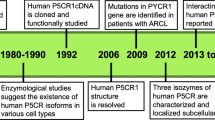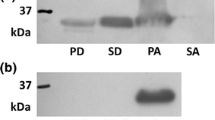Abstract
Monomeric carbonyl reductases (CBRs) are enzymes that catalyze the reduction of many endogenous and xenobiotic carbonyl compounds, including steroids and prostaglandins. There are two monomeric CBR genes in the human genome, cbr1 and cbr3, which exhibit high homology in their amino acid sequences. Human CBR1 (hCBR1) is known as prostaglandin 9-keto reductase and 15-hydroxy dehydrogenase, and regulates the metastasis of cancer cells through the regulation of prostaglandin metabolism. However, there is little information concerning the molecular and enzymatic characteristics of human CBR3 (hCBR3). The present study demonstrated the tissue and cellular localization, and catalytic activity of hCBR3. Semi-quantitative PCR revealed the ubiquitous but lower expression of hCBR3 compared with that of hCBR1. Bacterially expressed hCBR3 exhibited limited catalytic activity toward menadione, 4-benzoylpyridine, and 4-nitrobenzaldehyde. Similar results were obtained when the cell lysates of CBR-overexpressing HEK293 cells were examined. Additionally, neither the prostaglandin 9-keto reductase nor the 15-hydroxy dehydrogenase activities of hCBR3 were significant. Immunofluorescence staining revealed that ectopically expressed hCBR3 proteins were localized in the cytosol of HEK293 cells. These results suggested that hCBR3 and hCBR1 play distinct physiological roles. This study expands our understanding of the relationship between the two monomeric hCBRs and prostaglandin metabolism.




Similar content being viewed by others
References
Hoffmann F, Maser E (2007) Carbonyl reductases and pluripotent hydroxysteroid dehydrogenases of the short-chain dehydrogenase/reductase superfamily. Drug Metab Rev 39:87–144 doi:10.1080/03602530600969440
Oppermann U (2007) Carbonyl reductases: the complex relationships of mammalian carbonyl- and quinine-reducing enzymes and their role on physiology. Annu Rev Pharmacol Toxicol 47:17.1–17.30
Matsunaga T, Shintani S, Hara A (2006) Multiplicity of mammalian reductases for xenobiotic carbonyl compounds. Drug Metab Pharmacokinet 21(1):1–18 doi:10.2133/dmpk.21.1
Forrest GL, Gonzalez B (2000) Carbonyl reductase. Chem Biol Interact 129:21–40 doi:10.1016/S0009-2797(00)00196-4
Wermuth B, Platts KL, Seidel A, Oesch F (1986) Carbonyl reductase provides the enzymatic basis of quinine detoxification in man. Biochem Pharmacol Prov 35:1277–1282. doi:10.1016/0006-2952(86)90271-6
Wermuth B, Bohren KM, Heinemann G, von Wartburg JP, Gabbay KH (1988) Human carbonyl reductase. Nucleotide sequence analysis of a cDNA and amino acid sequence of the encoded protein. J Biol Chem 263:16185–16188
Watanabe K, Sugawara C, Ono A, Fukuzumi Y, Itakura S, Yamazaki M, et al (1998) Mapping of a novel human carbonyl reductase, CBR3, and ribosomal pseudogenes to human chromosome 21q22.2. Genomics 52(1):95–100 doi:10.1006/geno.1998.5380
Wei J, Dlouhy SR, Hara A, Ghetti B, Hodes ME (1996) Cloning a cDNA for carbonyl reductase (Cbr) from mouse cerebellum: murine genes that express cbr map to chromosomes 16 and 11. Genomics 34:147–148 doi:10.1006/geno.1996.0255
Olson LE, Bedja D, Alvey SJ, Cardounel AJ, Gabrielson KL, Reeves RH (2003) Protection from doxorubicin-induced cardiac toxicity in mice with a null allele of carbonyl reductase 1. Cancer Res 63:6602–6606
Wermuth B (1981) Purification and properties of an NADPH-dependent carbonyl reductase from human brain. Relationship to prostaglandin 9-keto reductase and xenobiotic ketone reductase. J Biol Chem 256:1206–1213
Takenaka K, Ogawa E, Oyanagi H, Wada H, Tanaka F (2005) Carbonyl reductase expression and its clinical significance in non-small-cell lung cancer. Cancer Epidemiol Biomarkers Prev 14(8):1972–1975 doi:10.1158/1055-9965.EPI-05-0060
Yokoyama Y, Xin B, Shigeto T, Umemoto M, Kasai-Sakamoto A, Futagami M, et al (2007) Clofibric acid, a peroxisome proliferator-activated receptor alpha ligand, inhibits growth of human ovarian cancer. Mol Cancer Ther 6:1379–1386 doi:10.1158/1535-7163.MCT-06-0722
Umemoto M, Yokoyama Y, Sato S, Tsuchida S, Al-Mulla F, Saito Y (2001) Carbonyl reductase as a significant predictor of survival and lymph node metastasis in epithelial ovarian cancer. Br J Cancer 85:1032–1036 doi:10.1038/sj.bjc.6692034
Ismail E, Al-Mulla F, Tsuchida S, Suto K, Motley P, Harrison PR, et al (2000) Carbonyl reductase: a novel metastasis modulating function. Cancer Res 60:1173–1176
Waclawik A, Ziecik AJ (2007) Differential expression of prostaglandin (PG) synthesis enzymes in conceptus during peri-implantation period and endometrial expression of carbonyl reductase/PG 9-ketoreductase in the pig. J Endocrinol 194:499–510 doi:10.1677/JOE-07-0155
Lakhman SS, Ghosh D, Blanco JG (2005) Functional significance of a natural allelic variant of human carbonyl reductase 3 (CBR3). Drug Metab Dispos 33:254–257 doi:10.1124/dmd.104.002006
Iwata N, Inazu N, Takeo S, Satoh T (1990) Carbonyl reductases from rat testis and vas deferens. Purification, properties and localization. Eur J Biochem 193:75–81 doi:10.1111/j.1432-1033.1990.tb19306.x
Bradford MM (1976) A rapid and sensitive method for the quantitation of microgram quantities of protein utilizing the principle of protein-dye binding. Anal Biochem 72:248–254 doi:10.1016/0003-2697(76)90527-3
Wirth H, Wermuth B (1992) Immunochemical characterization of carbonyl reductase in human tissues. J Histochem Cytochem 40:1857–1863 dehydrogenase, Proc Natl Acad Sci USA 90:502–506
Terada T, Sugihara Y, Nakamura K, Mizobuchi H, Maeda M (2003) Further characterization of Chinese hamster carbonyl reductases (CHCRs). Chem Biol Interact 143–144:373–381. doi:10.1016/S0009-2797(02)00208-9
Terada T, Sugihara Y, Nakamura K, Sato R, Sakuma S, Fujimoto Y, et al (2001) Characterization of multiple Chinese hamster carbonyl reductases. Chem Biol Interact 130–132:847–861. doi:10.1016/S0009-2797(00)00240-4
Tanaka M, Bateman R, Rauh D, Vaisberg E, Ramachandani S, Zhang C, et al (2005) An unbiased cell morphology-based screen for new, biologically active small molecules. PLoS Biol 3(5):e128. doi:10.1371/journal.pbio.0030128
Pilka ES, Rojkova A, Kavanagh KL, Niessen F, Sundstrom M, Arrowsmith C, et al (2006) Crystal structure of human carbonyl reductase 3, complexed with NADP+. Protein Data Bank, http://www.rcsb.org/pdb, Cited Jan 22, 2008
Iwata N, Inazu N, Satoh T (1989) The purification and properties of NADPH-dependent carbonyl reductases from rat ovary. J Biochem 105:556–564
Usami N, Kitahara K, Ishikura S, Nagano M, Sakai S, Hara A (2001) Characterization of a major form of human isatin reductase and the reduced metabolite. Eur J Biochem 268:5755–5763. doi:10.1046/j.0014-2956.2001.02510.x
Bohren KM, von Wartburg JP, Wermuth B (1987) Kinetics of carbonyl reductase from human brain. Biochem J 244:165–171
Tinguely JN, Wermuth B (1999) Identification of the reactive cystein residue (Cys227) in human carbonyl reductase. Eur J Biochem 260:9–14.doi:10.1046/j.1432-1327.1999.00089.x
Sciotti M, Wermuth B (2001) Coenzyme specificity of human monomeric carbonyl reductase: contribution of Lys-15, Ala-37 and Arg-38. Chem Biol Interact 130–132:871–878. doi:10.1016/S0009-2797(00)00242-8
Ghosh D, Sawicki M, Pletnev V, Erman M, Ohno S, Nakajin S, et al (2001) Porcine carbonyl reductase. Structural basis for a functional monomer in short chain dehydrogenases/reductases. J Biol Chem 276:18457–18463. doi:10.1074/jbc.M100538200
Jornvall H, Persson B, Krook M, Atrian S, Gonzalez-Duarte R, Jeffery J, et al (1995) Short-chain dehydrogenases/reductases (SDR). Biochemistry 34:6003–6013. doi:10.1021/bi00018a001
Tanaka N, Nonaka T, Tanabe T, Yoshimoto T, Tsuru D, Mitsui Y (1996) Crystal structures of the binary and ternary complexes of 7α-hydroxysteroid dehydrogenase from Escherichia coli. Biochemistry 35:7715–7730. doi:10.1021/bi951904d
Krook M, Ghosh D, Stromberg R, Carlquist M, Jornvall H (1993) Carboxyethyllysine in a protein: native carbonyl reductase/NADP+-dependent prostaglandin dehydrogenase. Proc Natl Acad Sci USA 90:502–506. doi:10.1073/pnas.90.2.502
Acknowledgements
This work was supported in part by a research grant from the Japan Food Chemical Research Foundation (T.T.), by the Osaka Ohtani University Research Fund (Pharmaceutical Science) (T.N.), and by a grant-in-aid for young scientists (B) 14771339 from the Ministry of Education, Culture, Sports, Science, and Technology, Japan (T.N.). The authors thank Mr. H. Mizobuchi for his participation in the initial stage in this research.
Author information
Authors and Affiliations
Corresponding author
Rights and permissions
About this article
Cite this article
Miura, T., Nishinaka, T. & Terada, T. Different functions between human monomeric carbonyl reductase 3 and carbonyl reductase 1. Mol Cell Biochem 315, 113–121 (2008). https://doi.org/10.1007/s11010-008-9794-5
Received:
Accepted:
Published:
Issue Date:
DOI: https://doi.org/10.1007/s11010-008-9794-5




